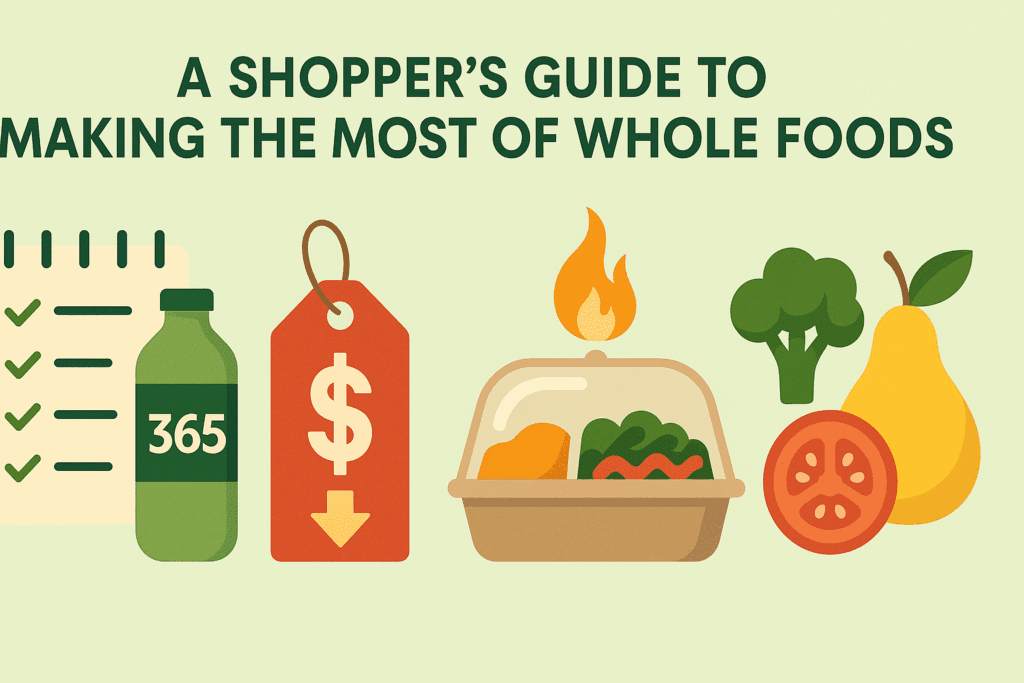Whole Foods Market has become a staple in the American wellness landscape, praised for its wide selection of organic produce, responsibly sourced proteins, and natural pantry items. But what do real shoppers actually think about their experience? The internet is flooded with Whole Foods reviews, each reflecting a distinct perspective on what makes the brand stand out—or not. From the convenience of curated meal kits to the appeal of sustainably harvested seafood, shoppers have voiced their praise and concerns across thousands of Whole Foods Market reviews. When you look deeper, these insights offer more than opinions; they reveal key strategies for mindful eating, smarter grocery shopping, and choosing nutritious options without sacrificing flavor or values.
Understanding the appeal of Whole Foods Market starts with examining how the store has positioned itself in the evolving world of healthy living. Shoppers increasingly seek transparency, ethical sourcing, and nutrient-dense foods that align with their personal values. As such, Whole Foods Market reviews often speak to more than just product quality—they reflect a larger cultural shift toward holistic wellness and conscious consumption. In this article, we dive deep into what real customers are saying, explore expert-backed interpretations of their experiences, and highlight which healthy grocery items are genuinely worth the hype and the price.
You may also like: How a Whole Foods Diet Supports Sustainable Weight Loss: Expert Tips for Eating Whole Foods to Lose Weight Safely

Why Whole Foods Still Dominates the Healthy Grocery Conversation
Despite the rise of health-focused competitors and direct-to-door grocery delivery services, Whole Foods continues to capture consumer loyalty. Many Whole Foods reviews applaud the brand for maintaining a consistent emphasis on product integrity. With third-party certifications like USDA Organic, Non-GMO Project Verified, and Fair Trade labeling, shoppers feel reassured that their purchases meet strict health and ethical standards.
Whole Foods Market reviews often emphasize the freshness of the produce and the uniqueness of the store-brand items, such as 365 by Whole Foods. Customers describe the 365 line as an affordable entry point into higher-quality food without the premium price tag often associated with the brand. Whether it’s cold-pressed juice, organic canned beans, or almond milk, the value proposition here is clear—nutrition can be accessible and aligned with everyday budgets.
Beyond pricing and product quality, shoppers appreciate the customer service and store atmosphere. Numerous Whole Foods reviews mention knowledgeable staff who are not only friendly but also well-informed about dietary needs and ingredient sourcing. This level of customer engagement creates a sense of trust and educational support, which is especially crucial for consumers navigating food sensitivities or new dietary changes like gluten-free, keto, or plant-based diets.

The Double-Edged Sword of Pricing: What Shoppers Really Think
Pricing remains one of the most hotly debated topics in Whole Foods Market reviews. Some customers feel the higher costs are justified by the store’s rigorous ingredient standards and superior quality. Others express frustration, stating that comparable items can be found for less at traditional grocers or other natural food retailers. However, many reviews also acknowledge that Whole Foods offers sales, Prime member discounts, and value-driven items that can help make healthful shopping more affordable.
One of the often-overlooked features mentioned in positive Whole Foods reviews is the rotating weekly sales. These markdowns, especially when combined with Prime membership benefits, can offer substantial savings on staples like organic fruits, grass-fed meats, and pantry essentials. Shoppers who plan ahead and focus on seasonal produce and sale items tend to walk away with more value per dollar spent.
Still, for individuals or families on a tight budget, the perception of Whole Foods as a “whole paycheck” store persists. Experts suggest shopping strategically by sticking to the store brand, buying in bulk, and taking advantage of the hot bar for balanced meals without the markup of restaurant dining. Understanding how to shop Whole Foods efficiently can change the overall cost narrative and lead to smarter spending.

What Shoppers Love About the Fresh Sections: Produce, Meat, and Seafood
When it comes to quality, Whole Foods Market reviews consistently praise the produce section. Fruits and vegetables are often described as exceptionally fresh, vibrantly colored, and reliably organic. For many health-conscious consumers, the produce aisle is where Whole Foods earns its reputation. Shoppers trust that they’re not only buying cleaner food but also supporting farming practices that are better for the planet.
In the meat department, Whole Foods continues to distinguish itself with its Global Animal Partnership (GAP) certification system, which offers transparency around how animals were raised. Customers who follow Whole Foods reviews closely note that this ethical transparency gives them peace of mind, especially when purchasing higher-cost items like grass-fed beef, pasture-raised chicken, or wild-caught fish.
Seafood selections also receive frequent acclaim in Whole Foods Market reviews. The company prioritizes sustainable fishing practices, and this commitment shows in the form of detailed signage and traceability for each item. From wild salmon to responsibly farmed shrimp, real shopper feedback suggests that Whole Foods delivers in both taste and environmental responsibility. For families seeking clean protein sources without antibiotics or hormones, this section is a frequent favorite.
Pantry Picks and Packaged Goods: Where Value Meets Quality
Pantry staples at Whole Foods range from organic grains and beans to artisanal sauces and gluten-free baking ingredients. Shoppers with dietary restrictions especially appreciate the extensive labeling and variety available. Whether you’re vegan, paleo, or managing a food allergy, Whole Foods reviews often highlight the store’s dedication to inclusive nutrition.
Whole Foods Market reviews repeatedly call out the wide assortment of plant-based proteins, nutrient-dense snacks, and clean-label condiments. Brands like Siete, Simple Mills, and Mary’s Gone Crackers are frequently found on the shelves, and many are exclusive or difficult to find elsewhere. Shoppers also praise Whole Foods for carrying items without artificial preservatives, colors, or sweeteners, reinforcing its commitment to clean eating.
The 365 by Whole Foods line plays a big role in how customers perceive value. Many reviewers state that they’ve discovered new pantry staples from this house brand, such as lentils, quinoa, and organic pasta sauces, all at a lower price than name-brand competitors. These insights underscore how Whole Foods remains accessible to budget-conscious consumers when approached with a strategic eye.

Prepared Foods and the Hot Bar: Convenience Without Compromise
One of the most talked-about features in Whole Foods Market reviews is the prepared foods section, especially the hot bar and salad bar. These stations offer a rotating menu of globally inspired dishes, catering to a variety of dietary preferences while maintaining Whole Foods’ ingredient integrity. Shoppers frequently mention the convenience of grabbing a nutrient-packed meal that’s both flavorful and free of artificial additives.
Nutrition experts often support this positive feedback, citing Whole Foods’ attention to macronutrient balance, portion control, and ingredient transparency. Many dishes are labeled with key nutrition details and dietary indicators, making it easier for shoppers to make informed choices. For busy professionals, this offering becomes more than a convenience—it serves as a bridge between intention and action when it comes to eating well on a tight schedule.
Yet some reviewers mention concerns over price per pound, especially when building larger meals from the hot bar. Others suggest improvements in consistency or freshness during off-peak hours. Nonetheless, most agree that when chosen thoughtfully, the prepared food offerings at Whole Foods strike a rare balance between clean ingredients and culinary satisfaction.

Wellness and Supplement Aisles: A Mixed Bag of Praise and Caution
Whole Foods Market reviews regarding the wellness and supplement aisles reveal both enthusiasm and skepticism. On the one hand, shoppers value the breadth of options, from adaptogenic herbs and organic protein powders to probiotics and multivitamins. Many mention the assistance of in-store wellness staff who provide knowledgeable guidance without aggressive sales tactics.
However, not all reviews are glowing. Some shoppers express concern over price markups compared to online retailers. Others point to the overwhelming variety and difficulty discerning which supplements are backed by solid research. Experts recommend that consumers cross-reference product claims with credible scientific sources or consult a registered dietitian before purchasing unfamiliar supplements.
Despite the mixed feedback, Whole Foods’ strict quality standards ensure that most offerings are free from synthetic fillers and common allergens. This quality assurance is frequently cited in positive Whole Foods reviews and reinforces the store’s reputation as a trusted destination for those pursuing integrative or functional health approaches.

Local Sourcing, Sustainability, and Social Responsibility
Whole Foods Market reviews frequently reflect an appreciation for the company’s commitment to supporting local producers and environmentally responsible practices. Shoppers who value sustainability note the store’s efforts to reduce packaging waste, promote reusable bags, and feature regionally grown produce. In some locations, customers can even find hyper-local items like honey, kombucha, or bread from nearby artisans.
This emphasis on community and ecological responsibility sets Whole Foods apart for many mindful eaters. The store’s sustainability metrics, including seafood sustainability ratings and animal welfare certifications, provide transparency that resonates with values-driven consumers. Many reviewers express that these efforts influence their loyalty more than price alone.
From fair-trade coffee to plastic-free packaging, shoppers feel empowered by the knowledge that their purchases contribute to broader environmental and social causes. For individuals trying to align personal wellness with planetary health, this added layer of meaning becomes a key driver in their shopping decisions—one that is consistently reflected in Whole Foods reviews.

A Shopper’s Guide to Making the Most of Whole Foods
Expert analysis of Whole Foods Market reviews points to clear strategies for getting the best value from your shopping experience. First, plan your trip around weekly sales and seasonal produce to maximize freshness and affordability. Utilizing the Prime member discount can unlock additional savings, especially on high-cost items like organic meat and specialty pantry goods.
Second, explore the store-brand offerings within the 365 line. These products maintain Whole Foods’ ingredient standards at a more accessible price point, making them ideal for repeat purchases. From canned tomatoes to olive oil, these options frequently outperform their brand-name counterparts in both cost and nutrition.
Third, approach the store’s layout with a strategic mindset. Begin with the fresh sections, build your meals around whole ingredients, and use packaged goods to complement rather than dominate your cart. Shoppers who follow this pattern often report a more balanced grocery haul that aligns with their wellness goals and budget constraints.
Frequently Asked Questions: What Real Shoppers Say in Whole Foods Market Reviews
1. How have shopper priorities evolved in recent Whole Foods reviews, especially post-pandemic? Recent Whole Foods reviews show a noticeable shift in consumer priorities toward immunity-boosting foods, local sourcing, and mental wellness products. Post-pandemic shoppers are not only evaluating nutritional labels but also looking for transparency about supply chains and environmental sustainability. Many reviews mention an increased demand for adaptogenic herbs, probiotic-rich items, and natural mood enhancers, indicating a more holistic approach to health. Additionally, shoppers are paying closer attention to the hygiene standards of the store itself, highlighting how trust and cleanliness have become non-negotiable in choosing where to buy groceries. This shift suggests that Whole Foods is now more than just a grocery store—it serves as a barometer of evolving public health consciousness.
2. Are there any overlooked product categories that deserve more attention in Whole Foods Market reviews? While Whole Foods Market reviews often spotlight produce and prepared foods, many shoppers overlook the wellness and beauty sections, which have significantly expanded in recent years. Products like aluminum-free deodorants, sulfate-free shampoos, and herbal skin treatments are gaining traction among health-conscious consumers seeking non-toxic personal care. Some reviews also praise the availability of cruelty-free and zero-waste options, which align with the store’s broader sustainability mission. Another underappreciated area is the international foods aisle, which features a growing selection of authentic, minimally processed ethnic staples that support culinary diversity. Recognizing these lesser-known sections allows shoppers to fully tap into the store’s potential as a one-stop destination for total wellness.
3. How do Whole Foods reviews compare between urban and suburban store locations? Whole Foods reviews can vary significantly depending on the store’s location, with urban reviews often focusing more on store crowding, limited parking, and higher turnover of fresh goods. In contrast, suburban reviews tend to highlight larger store layouts, easier navigation, and more consistent stock of bulk items. Some suburban shoppers report a deeper connection to local farms and producers due to closer geographic proximity, which enhances the feeling of community sourcing. Meanwhile, urban reviewers often appreciate the access to niche dietary products and fast grab-and-go options that cater to a busy lifestyle. These differences reflect how Whole Foods adapts its layout and offerings to meet the specific needs of each demographic region.
4. What trends in plant-based living are emerging from Whole Foods Market reviews? Whole Foods Market reviews increasingly show that plant-based living is evolving beyond just tofu and almond milk. Shoppers are excited about newer innovations like lentil-based pastas, chickpea snacks, jackfruit entrées, and dairy-free cheese alternatives made from cashews or oats. Many reviewers express appreciation for the growing availability of soy-free and gluten-free vegan products, allowing them to maintain diverse and inclusive diets. There is also mention of the rise in meat analogues that mimic the taste and texture of real meat without heavily relying on processed ingredients. As sustainability becomes a larger concern, customers are leaning toward whole-food-based vegan products rather than highly engineered alternatives, a nuance clearly reflected in recent whole foods market reviews.
5. How does customer service factor into consumer trust according to Whole Foods reviews? Many Whole Foods reviews emphasize how exceptional customer service contributes to brand loyalty. Shoppers often praise staff for being well-informed about complex topics like food allergies, nutrition labels, and sustainability practices. In particular, the in-house dietitians and knowledgeable team members in the supplement aisle are highlighted for their ability to guide customers through unfamiliar wellness products. Moreover, consistent employee friendliness and responsiveness to feedback enhance the in-store experience, especially for new customers unfamiliar with the brand. These soft skills foster a sense of trust that goes beyond product quality and positions Whole Foods as a dependable wellness partner.
6. Do Whole Foods Market reviews indicate growing demand for educational resources in-store? Yes, several recent Whole Foods Market reviews express a desire for more educational signage, recipe ideas, and interactive tools that help consumers make better food choices. With the increasing complexity of dietary trends and ingredient awareness, shoppers are craving not just information, but context—such as the environmental impact of a food item or how it fits into a balanced meal plan. Some stores have started offering cooking demonstrations, guided tastings, and QR codes linking to nutrition guides, and customers are responding positively. This signals an opportunity for Whole Foods to double down on its role as an educator as well as a retailer. The more empowered shoppers feel, the more likely they are to return and explore new categories.
7. What do Whole Foods reviews reveal about generational shopping differences? Whole Foods reviews subtly reveal generational divides in shopping behavior. Younger customers, including millennials and Gen Z, often focus on ethical sourcing, eco-friendly packaging, and digital convenience, including mobile app features and delivery integration. They tend to explore newer product categories like CBD oils, sustainable household goods, and biodynamic wines. In contrast, Gen X and baby boomers often emphasize product consistency, in-store experience, and traditional wellness items like fish oil, organic meats, and classic supplements. The reviews reflect how Whole Foods is uniquely positioned to cater to all age groups by offering tailored experiences across generations. This ability to bridge wellness values through multiple lenses is part of what strengthens its reputation in whole foods market reviews.
8. How are seasonal offerings viewed in Whole Foods reviews, and do they impact shopping behavior? Seasonal offerings generate a lot of buzz in Whole Foods reviews, often acting as triggers for impulse buys or special family traditions. Items like pumpkin spice almond milk, winter squash medleys, and cranberry goat cheese become recurring favorites that shoppers anticipate each year. These limited-time products create a sense of urgency and emotional connection, which enhances customer engagement. Additionally, seasonal produce is often priced more competitively and showcases local farms, adding another layer of value. Reviews suggest that seasonal offerings not only drive foot traffic but also shape long-term brand loyalty as they become rituals tied to holidays and wellness-focused lifestyle transitions.
9. What practical strategies can shoppers extract from Whole Foods reviews to save money while eating well? Whole Foods reviews frequently offer clever strategies for budget-conscious shopping. Savvy customers recommend syncing grocery trips with Prime member discount days and planning meals around weekly sales highlighted in the app. Others suggest building meals around affordable staples in the 365 product line, such as canned beans, frozen vegetables, and whole grains. Buying bulk spices or using the hot bar strategically (like for protein add-ons) can stretch dollars while maintaining a nutrient-dense diet. These insider tips shared across hundreds of whole foods market reviews show that with a thoughtful plan, it’s possible to shop at Whole Foods without overspending.
10. How might Whole Foods evolve based on recurring themes in whole foods market reviews? If you analyze recurring themes in whole foods market reviews, it’s clear that future evolution could hinge on technology, personalization, and deeper integration of wellness services. Many shoppers express interest in customizable nutrition plans, AI-guided meal planning apps, and even telehealth consultations available through the wellness section. Others envision a more immersive educational experience with virtual store tours or augmented reality features to decode food sourcing. These ideas suggest that the next phase of Whole Foods could blur the lines between grocery, health coaching, and lifestyle curation. As the brand continues to collect and respond to customer feedback, it will likely shape the future of mindful retail itself.
Conclusion: What Whole Foods Reviews Reveal About Smarter Shopping and Healthier Living
After analyzing hundreds of Whole Foods Market reviews, a consistent theme emerges: shoppers value transparency, quality, and alignment with ethical principles. While concerns about pricing persist, savvy consumers recognize that Whole Foods offers unique advantages in terms of clean ingredients, sustainability, and personalized service. The store may not be the cheapest option, but for those who prioritize nutrient-rich foods and environmentally responsible practices, it delivers distinct value.
Expert insights suggest that the best way to navigate Whole Foods is with intention. Know your priorities, use available discounts, and explore the store’s wide array of options with a focus on whole, minimally processed foods. Whole Foods reviews don’t just offer critiques; they offer a roadmap for mindful consumption that supports both individual and planetary health.
In a world where food choices are increasingly tied to long-term wellness, understanding what real shoppers say in Whole Foods Market reviews can empower you to make decisions that nourish more than just your body. They reflect a growing consciousness about what it means to eat well—not just for taste, but for life.
Was this article helpful? Don’t let it stop with you. Share it right now with someone who needs to see it—whether it’s a friend, a colleague, or your whole network. And if staying ahead on this topic matters to you, subscribe to this publication for the most up-to-date information. You’ll get the latest insights delivered straight to you—no searching, no missing out.
Further Reading:
Whole Foods Market Forecasts Top 10 Food Trends for 2024
Skip the Store: These Are the Best Grocery Delivery Services for Every Budget
Shopping at Whole Foods Market: My Must-Haves and Can-Find-Elsewheres.
Disclaimer
The information contained in this article is provided for general informational purposes only and is not intended to serve as medical, legal, or professional advice. While NewsHealthWatch strives to present accurate, up-to-date, and reliable content, no warranty or guarantee, expressed or implied, is made regarding the completeness, accuracy, or adequacy of the information provided. Readers are strongly advised to seek the guidance of a qualified healthcare provider or other relevant professionals before acting on any information contained in this article. NewsHealthWatch, its authors, editors, and contributors expressly disclaim any liability for any damages, losses, or consequences arising directly or indirectly from the use, interpretation, or reliance on any information presented herein. The views and opinions expressed in this article are those of the author(s) and do not necessarily reflect the official policies or positions of NewsHealthWatch.

